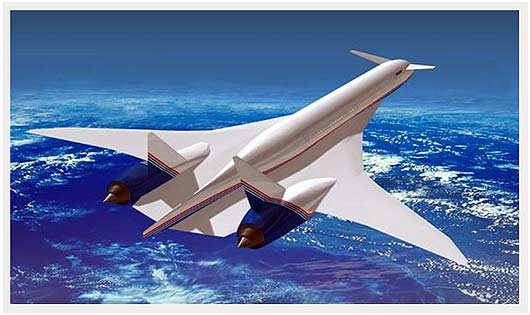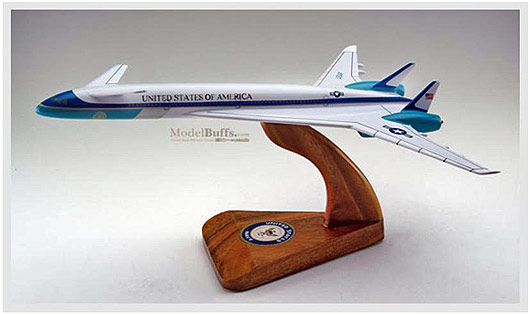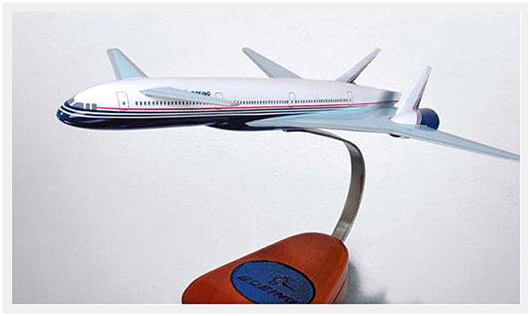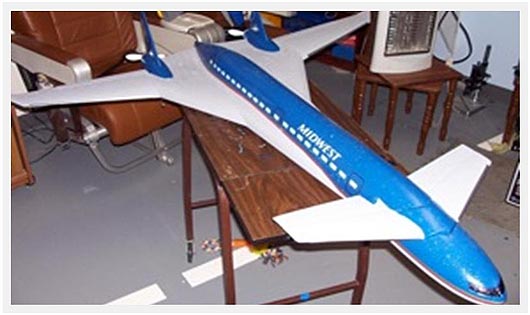Sonic Cruiser: Back To The Future - Includes In Flight Video!?
 Friday, February 26, 2010 at 02:11PM
Friday, February 26, 2010 at 02:11PM 
 Boeing's Circa 2001 Sonic Cruiser concept for near supersonic air travel
Boeing's Circa 2001 Sonic Cruiser concept for near supersonic air travel
(8 pix + 1 video)
Now that the 787 era is finally off the ground, it’s kinda cool to look back at what Boeing was telling us the future of air travel was circa 2001. This very cool collection of renderings, models, and a video can sure stir the imagination!
It was December of 2000 when Airbus committed to the A380 project with the hope of knocking the 747 off of the throne as the high capacity airliner to the world. Boeing certainly had to respond, especially since it had already been 7 years sine the 777 had first flown. Boeing needed to show the industry how it was planning to meet the changing needs of the world’s travelers.
Enter the Sonic Cruiser concept. In March 2001, Boeing went public with a pretty radical looking design for a 200 to 250 seat airliner capable of cruising just short of the speed of sound, .95 - .98 Mach. The general idea was that the bulky hub and spoke method of moving people around was not what the airlines or passengers ultimately wanted. But the A380 with its rather massive pax capacity was certainly not going to fit a direct point-to-point model of operation. Boeing reasoned that smaller capacity aircraft would fit the point-to-point, nonstop model that travelers clearly preferred, and best of all, the Sonic Cruiser would get ’em there fast.

 Subtle differences are visible when looking closely at all these Boeing renderings
Subtle differences are visible when looking closely at all these Boeing renderings
The general design concept presented was pretty shocking, largely because Boeing was actually talking seriously about the aircraft. You see some wild designs artistically rendered from aerospace companies from time to time, but you don’t very often hear their leaders talking seriously about pursuing them. Yet, the CEO of Boeing Commercial Airplanes at the time, Alan Mulally, was talking like the Sonic Cruiser project wasn’t far from cutting parts for a prototype.
In hindsight, I’m a little more likely to believe that the whole project had more to do with controlling Boeing's perception in the industry than it did with the serious pursuit of the radical design concept. The fact that the airplane also looked like a mashup of the Starship, SR-71 and Concorde also makes me think that what we saw was at least 75% PR trickery. But that’s not to say that it wasn’t feasible as it was shown… and I’d still be drooling if that first flight we saw on December 15, 2009 had been of the Sonic Cruiser instead of the 787.
Either way, the events of September 11, 2001 changed the dynamics of the airline industry forever, and as airlines struggled to even survive, the future pointed to a far greater need for economical, super-efficient aircraft rather than a semi-efficient aircraft with near supersonic speeds. By December 2002, the Sonic Cruiser project had been officially abandoned. Shortly after, in late January 2003, Boeing announced that their new aircraft design efforts would be centered on the emerging need for an airplane with tradition cruise speeds but operating costs reduced by 20% thru maximization of efficient design. That began the 7E7 project which eventually became the 787.
 Very cool Boeing model of the Sonic Cruiser photo: FlightBlogger
Very cool Boeing model of the Sonic Cruiser photo: FlightBlogger
 Sonic Cruiser display model in Air Force One colors from modelbuffs.com
Sonic Cruiser display model in Air Force One colors from modelbuffs.com
 Sonic Cruiser display model in Boeing colors from warplanes.com
Sonic Cruiser display model in Boeing colors from warplanes.com
Now, we’re mostly left with these cool renderings of the Sonic Cruiser to tickle the dreamy parts of our minds. But I did find a few more interesting items to make the concept all a bit more real. First are a couple of sweet looking Sonic Cruiser display models. One from warplanes.com with Boeing markings, and another from modelbuffs.com with a conceptual Air Force One scheme.
And then, I stumbled upon a nifty video of a foam and electric RC model based on the Sonic Cruiser. It’s called the Sonic Liner, and it not only represents the look of the Cruiser, but man does it ever look great in flight! Apparently it was sold thru Multiplex but hasn’t been available for a while.
The video at least makes it seem like the concept might have worked well had the Sonic Cruiser actually been advanced as the future of airline travel. One element that remains a mystery tho is whether or not Boeing really had any practical answers on how to cruise at .95 to .98 Mach both safely and efficiently. I’ll try to do some deeper research on that and see if there any evidence to suggest that they were really on to something. Regardless, the Sonic Cruiser is a fascinating part of the history of Boeing Commercial Airplanes, and it sure is interesting to imagine… what if.
 Foam and electric 'Sonic Liner' RC model photo: flyingelectrons.com
Foam and electric 'Sonic Liner' RC model photo: flyingelectrons.com
 Martt |
Martt |  3 Comments |
3 Comments | 













































































Reader Comments (3)
I really like this blog post, it has some great info. Thank you and keep up good work.
algarve flight
I worked at Boeing at the time but never on the Sonic Cruiser. After hearing about the plan for a transonic airliner a friend and I tried to figure out what it would look like. It needed to follow the area rule but we knew that a Coke bottle fuselage wouldn't be practical, it needed to be constant diameter most of it's length. We sketched up sort of a twin jet long-ez so that the fuselage taper and and wing would follow the area rule. A few months later when the secrecy was lifted we weren't surprised.
carldaev e3d3fd1842 https://mug.vn/ragcarobla